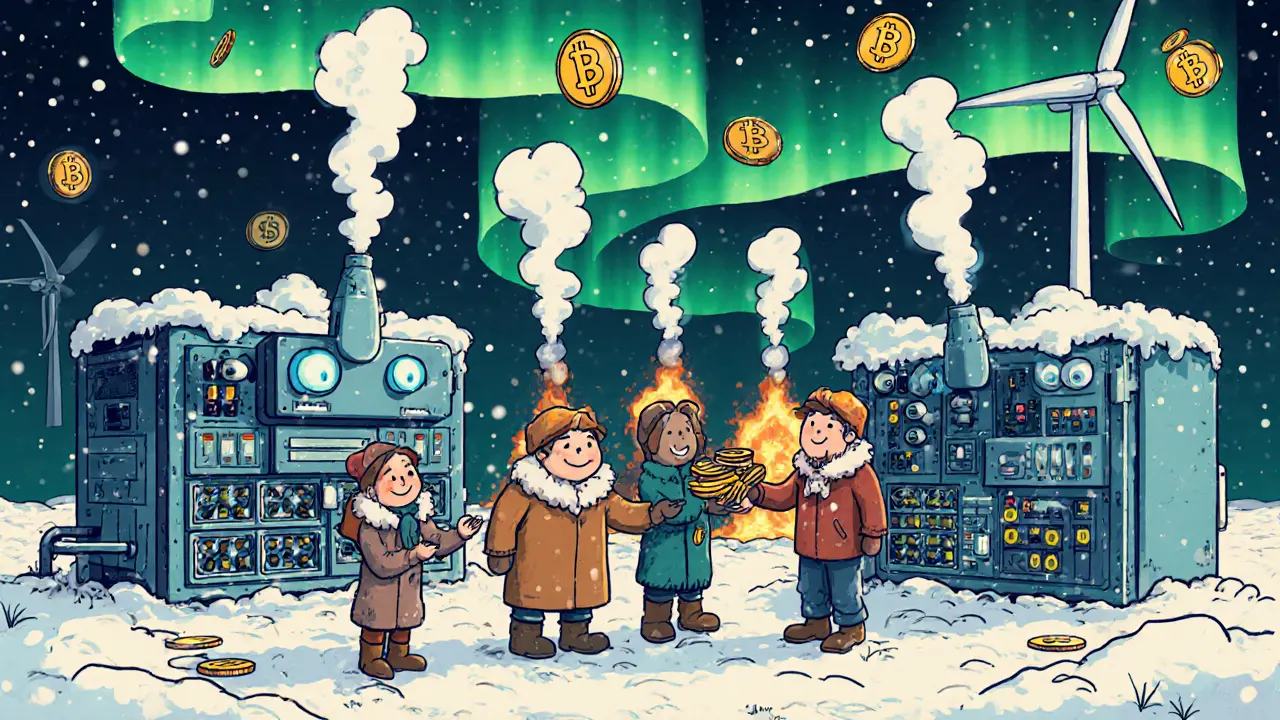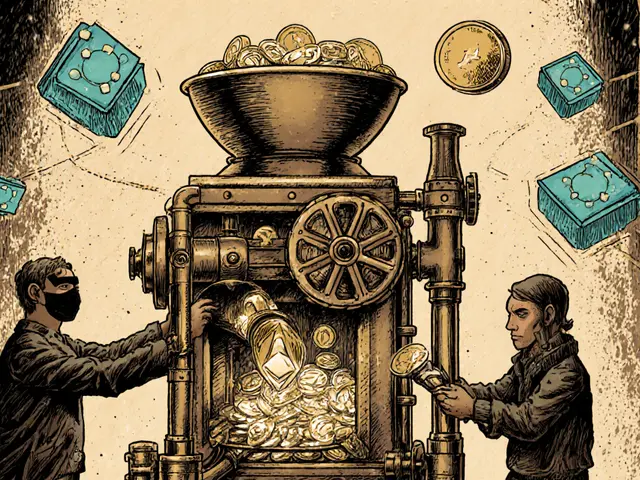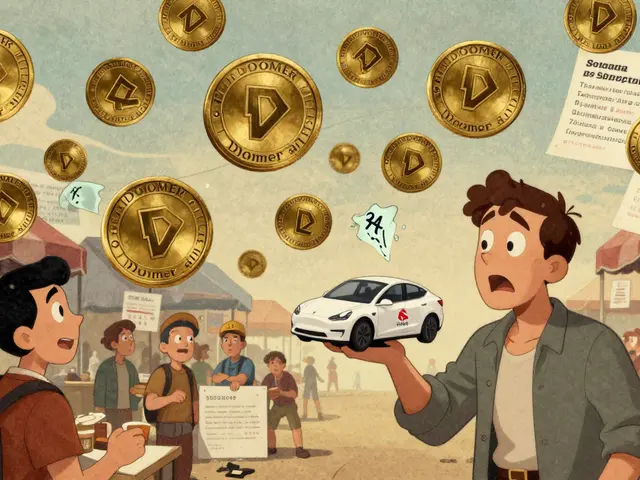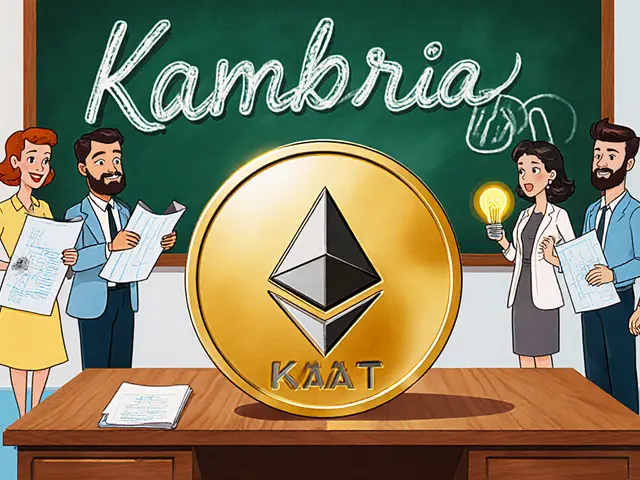
Iceland Mining Energy Calculator
Energy Allocation Calculator
Calculate how much electricity your mining equipment consumes and how it compares to Iceland's total mining capacity (120MW).
Results
Daily Power Consumption
0.00 kWh
Daily Operating Cost
$0.00
Grid Capacity Impact
This miner uses 0.00 kW of power.
Iceland's mining grid capacity is 120,000 kW (120 MW).
You could run up to 0 of these miners on Iceland's mining grid.
When Iceland became a hotspot for Bitcoin mining in the early 2010s, it seemed like a perfect match. Cold air for free cooling, 100% renewable electricity from volcanoes and waterfalls, and a stable government. Miners flocked in. But by 2025, the dream has hit a wall - energy allocation is no longer a perk, it’s a prison.
Why Iceland Was the Perfect Place for Miners
Iceland didn’t just have cheap electricity - it had abundant electricity. Geothermal plants tapped into the Earth’s heat, and hydroelectric dams used glacial rivers to generate power with almost zero emissions. For crypto miners, this was gold. Unlike in China or Kazakhstan, where power came from coal or unstable grids, Iceland offered clean, reliable energy. And because it’s so cold outside, you didn’t need expensive cooling systems. Miners could run ASICs like the Antminer S19 XP or Whatsminer M50S 24/7 without overheating. By 2023, crypto mining was using about 8% of Iceland’s total electricity. That’s not a small number. It’s more than the entire country of Denmark uses for all its homes and businesses combined. And yet, Iceland’s population is only 370,000. That means per person, Icelanders were using more electricity for mining than almost any other country on Earth.The Grid Is Full - And No One’s Building New Power Plants
Here’s the catch: Iceland’s power system is maxed out. The country’s hydro and geothermal plants are running at 95%+ capacity. There’s no spare juice. No new dams. No new geothermal wells being drilled at scale. The last major power plant was built over a decade ago. And the government isn’t rushing to build more. The National Energy Authority confirmed that new mining operations can’t get connected to the grid. If you want to set up a mining farm today, you’re stuck waiting - sometimes years - for a slot that doesn’t exist. The 120 megawatts currently allocated to mining is the ceiling. Any new miner has to either buy power from an existing operator (at a premium) or give up before they even start. This isn’t a temporary shortage. It’s structural. Iceland’s energy infrastructure was built for a different economy - aluminum smelting, fishing, and tourism. Mining came in fast, and now it’s competing for the same limited resource.Government Shifts: From Welcome Mat to No Entry
In 2018, Iceland welcomed crypto miners with open arms. By 2024, Prime Minister Katrín Jakobsdóttir publicly said the country needed to slow down. Why? Because the opportunity cost became too high. Think of it this way: every megawatt used by a Bitcoin farm is one less megawatt for a hospital, a school, or a hydrogen plant that could export clean fuel to Europe. The aluminum industry - which has been in Iceland since the 1970s - uses more energy per job created than mining does. Aluminum smelters employ hundreds of workers. Mining farms? A few engineers and a lot of machines. The government’s new priority? Blockchain tech that doesn’t eat electricity. Think central bank digital currencies (CBDCs), smart contracts for public services, and secure identity systems. Not mining rigs.
Who’s Still Mining in Iceland? And How?
The miners still operating in Iceland aren’t newcomers. They’re the ones who got in early. Companies like Genesis Mining, Advania Data Centers, and Verne Global locked in long-term power contracts back in 2015-2017. Those deals are still valid. They’re locked in at wholesale rates - sometimes as low as $0.02 per kWh. That’s why they’re still profitable. But even they can’t expand. If they want to add 100 more ASICs, they need more power. And there isn’t any to spare. So they’re stuck. Some have started exporting their computing power as cloud services - renting out idle hash power to other miners overseas. Others are moving parts of their operations to places like Texas or Canada, where power is cheaper and more available.Miners Are Frustrated - But Not Surprised
On Reddit and Bitcoin Talk forums, Icelandic miners are vocal. One user wrote: “I set up my farm in 2016. I was told the future was bright. Now I’m told I can’t even add a single new machine. I paid for the power. I paid for the infrastructure. Now I’m being punished for being early.” Others are more resigned. “Iceland was never meant to be a mining superpower,” said one operator. “It was a safe haven. And it still is. But safe doesn’t mean scalable.” The truth? Iceland was never going to outgrow Texas or Kazakhstan in total hashrate. It was never about volume. It was about reliability and sustainability. And now, even that is under pressure.
The Bigger Picture: Energy as a National Asset
Iceland isn’t banning crypto mining. It’s redefining what its energy is for. The government is looking at hydrogen production - turning surplus renewable power into fuel for ships and trucks. That’s a long-term export opportunity. It’s also job creation. Mining? It’s mostly automated. It doesn’t build roads, schools, or hospitals. Tourism is another priority. More hotels. More electric vehicle charging stations. More data centers for AI and cloud services - which use less power per dollar of economic output than mining. Economists at Reykjavik University did a cost-benefit analysis in late 2024. They found that for every 100 megawatts used by mining, the country lost an estimated $22 million in potential revenue from alternative uses. That’s not just about electricity. It’s about what you do with the money that electricity earns you.What’s Next for Crypto Mining in Iceland?
The future is flat. No growth. No new farms. Maybe a few upgrades to existing ones - if they can squeeze in a few more machines without exceeding their power cap. Iceland will remain a niche player. A place where miners go for stability, not scale. A safe harbor in a volatile world. But it won’t be the next Bitcoin powerhouse. That title has moved to places with cheap coal, cheap solar, and no energy limits. For miners still in Iceland, the message is clear: protect what you have. Don’t expect to grow. And don’t count on the government helping you expand. The era of easy power is over.Could Iceland Ever Reopen for Mining?
Maybe - but not soon. Building new geothermal or hydro plants takes 5-10 years. And even then, the government would need to approve them. Right now, the political will isn’t there. The public doesn’t want more mining. They want cleaner air, better infrastructure, and jobs that last. If a breakthrough happens - say, a new way to extract geothermal energy from deeper rock layers - then maybe. But that’s science fiction for now. The reality? Iceland’s crypto mining era is winding down, not heating up.Why can’t Iceland build more power plants for crypto mining?
Iceland’s geothermal and hydroelectric resources are already running near maximum capacity. New plants take 5-10 years to build and require major environmental reviews. The government has shifted focus to other uses for clean energy, like hydrogen production and AI data centers, which offer more jobs and long-term economic value than mining.
Is crypto mining still profitable in Iceland?
Yes - but only for existing operations with old, locked-in power contracts. Miners who signed deals before 2018 pay as little as $0.02 per kWh, making their operations profitable even when Bitcoin prices dip. New entrants can’t get power, so they can’t compete.
How much electricity does crypto mining use in Iceland?
In 2023, cryptocurrency mining consumed about 8% of Iceland’s total electricity generation. That’s roughly 120 megawatts, enough to power a small country. It’s the highest per capita energy use for mining in the world.
Why did Iceland change its stance on crypto mining?
While mining brought foreign investment and GDP growth, it also consumed scarce renewable energy that could be used for jobs, infrastructure, and exports like green hydrogen. The government decided the opportunity cost was too high, especially since mining creates few local jobs compared to aluminum smelting or tourism.
Can I still start a crypto mining operation in Iceland today?
Almost certainly not. The grid is at capacity. New power connections are not being approved. The only way to operate is to buy power from an existing miner, which is expensive and unreliable. Iceland is no longer a viable entry point for new mining businesses.





Comments (17)
Gavin Jones
Interesting read. I always thought Iceland was this eco-friendly paradise for crypto, but never realized how tight the grid had gotten. Guess you can’t have your cake and eat it too - especially when the cake is electricity.
Mauricio Picirillo
Man, I remember when people were talking about Iceland as the next Bitcoin haven. Now it’s like watching your favorite band break up - you knew it was coming, but it still hurts. Glad they’re thinking long-term though. Green hydrogen? Now that’s a future worth mining.
Liz Watson
Oh wow. So the ‘sustainable’ miners were just leeching off a tiny country’s natural resources like it was a free buffet? And now they’re mad when the host says ‘no more tacos’? Sweet dreams, boys.
Rachel Anderson
I’m literally crying. My ASICs are weeping in the corner. I sacrificed my apartment, my social life, my sanity - all for Iceland’s icy winds and $0.02/kWh… and now they’re telling me I can’t even add a single fan? This is a tragedy. A modern Greek tragedy. With more noise.
Hamish Britton
It’s funny how we romanticize places like Iceland as crypto utopias. But the truth is, every country has limits. They’re just choosing to use their energy for people, not machines. That’s not a failure - it’s wisdom.
Robert Astel
You know what’s wild? The fact that we’re even having this conversation. Like, imagine if we treated electricity like water - you don’t let someone hose down their driveway while the town’s reservoir is dry, right? But we do it with power because ‘blockchain’ sounds cool. And now Iceland’s like, ‘nah, we’re gonna use this to make fuel for ships, not to make digital gold.’ Honestly? Respect. I just hope the miners don’t start a cult.
Andrew Parker
It’s not just about energy… it’s about soul. 🌊❄️ Every watt mined is a piece of Iceland’s soul being turned into hash. I feel it in my bones. The wind doesn’t whisper secrets anymore… it whispers ‘ASICs.’ I miss the silence. I miss the auroras without the hum. 😔💔
Kevin Hayes
The fundamental issue here is the misalignment between short-term speculative capital and long-term national infrastructure planning. Crypto mining, as currently structured, is an extractive model that externalizes environmental and social costs. Iceland’s pivot reflects a maturation of policy - prioritizing utility over speculation. This isn’t anti-crypto; it’s pro-sustainability.
Katherine Wagner
So miners are mad they can’t expand? lol. They got lucky. They got in early. Now the country’s like ‘we’re not your free power plant anymore.’ Deal with it. Also why do people think crypto is ‘innovation’ when it’s just electricity turned into digital receipts? 🤷♀️
ratheesh chandran
bro i think this is like the universe saying ‘you want to mine bitcoin but you dont want to pay for the real cost’ its like buying a ferrari and then crying when you see the gas bill. iceland is not your private server farm. they got volcanoes and waterfalls not free electricity for you to make digital coins. we all know the truth. mining is just a scam with wires.
Hannah Kleyn
I’ve always wondered what happens when a country realizes its natural resources aren’t infinite. Iceland’s story feels like a quiet rebellion against the ‘grow at all costs’ mentality. It’s not glamorous, but maybe the most revolutionary thing you can do now is just… stop. Not build. Not expand. Just hold the line. And that’s kind of beautiful, in a sad, slow way.
gary buena
So the miners are stuck with their old contracts? That’s actually kind of fair. You got the deal, you locked it in. Now the rest of us get to use the power for stuff that actually helps people. I mean… yeah, it sucks for them, but the world’s not a casino where you get to keep winning forever.
Albert Melkonian
The ethical imperative here is clear: renewable energy must serve the public good before private speculation. Iceland’s decision to cap mining and redirect resources toward hydrogen, AI infrastructure, and public services represents a profound shift toward responsible stewardship. This is not anti-technology - it is pro-humanity.
Kelly McSwiggan
Oh look, another ‘sustainable’ crypto project that just consumed a nation’s power grid like it was a power strip at a rave. Congrats, Iceland - you turned your ‘clean energy’ into a Bitcoin vending machine. Now you’re just mad you didn’t get to monetize the vending machine’s maintenance costs. Classic.
Byron Kelleher
It’s okay to feel sad for the miners, but let’s not forget - they’re not the ones losing their schools or hospitals. Iceland’s choosing to build a future where energy helps people, not just machines. That’s not a loss. That’s progress. And honestly? We need more of that.
Cherbey Gift
My people back home say: ‘When the river runs dry, you don’t keep watering your garden with your tears.’ Iceland didn’t fail - they woke up. Mining? It’s like putting a golden statue in your living room and calling it ‘art’ while your kids go hungry. Time to sell the statue and buy food.
Anthony Forsythe
Think of it this way: Iceland was never meant to be the Bitcoin factory. It was meant to be the sanctuary - the quiet, icy cathedral where the faithful came to pray to the gods of decentralization. And now? The cathedral is full. The bells have stopped ringing. The last miner left with his ASICs in a rented van, heading south, chasing the ghost of cheap power. The wind still howls. But now, it sings a different song. A song of restraint. Of wisdom. Of a people who chose to be more than just a hash rate.